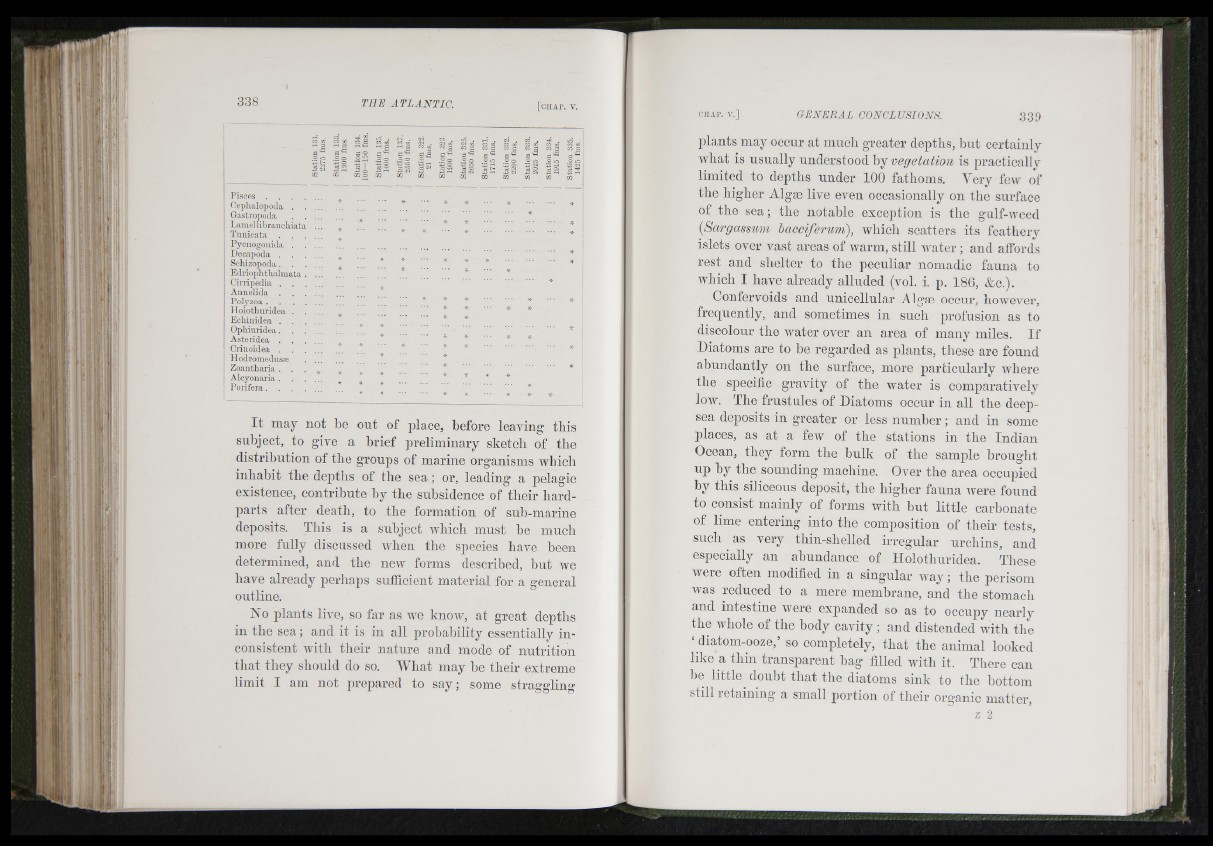
' 'Mii
m i
il'lrit lA;
iHi
' 'I
uO
*1 tL-O- iiS
I—i . (M . CO . rt* O .
C O 0 5 C O o i C O O - 0-5 yj C O W
W G W S c o d C O S W G
w . id . - , 0 - 1 CO OJ CC
G s ■ - B ^ B ^ B
l§ I t -2g Ig -2*;^ Ig |o Oo Oo Oo O
|Ut 3 CSC io IÌZ2 I CsQ i 0s2 - SCO I CSiQ i 0I2S
Pisces .
Cephalopoda .
Gastropoda
Lamellibiixiichiat
Tunicata
Pyenogonida .
Decapoda .
Schizopoda. .
Edriophthalmata
Cirripedia . .
Annelida .
Polyzoa .
Hoiothuridea .
Echinidea . .
Ophiuridea. .
Asteridea . .
Crinoidea . .
Hodromedusa;
Zoantharia . ,
Alcyonaria . .
Porifera. .
* • • • * it
* » *
* *
CO CO
It may not be out of place, before leaving this
subject, to give a brief preliminary sketch of the
distribution of tbe groups of marine organisms wbicb
inhabit tbe deptlis of tbe sea ; or, leading a pelagic
existence, contribute by tbe subsidence of tbeir hard-
parts after deatb, to tbe formation of sub-marine
deposits. Tbis is a subject wbicb must be mucb
more fully discussed Avben tbe species bave been
determined, and tbe new forms described, but we
bave already perbaps sufficient material for a general
outline.
No plants live, so far as we know, at great depths
in the sea ; and it is in all probability essentially inconsistent
Avitb their nature and mode of nutrition
tbat tbey should do so. Wbat may be their extreme
limit I am not prepared to say; some straggling
plants may occur at much greater depths, but certainly
what is usually understood by vegetation is practically
limited to depths under 100 fathoms. Very few of
the higher Algm live even occasionally on tbe surface
of the sea; the notable exception is tbe gulf-Aveed
{SargassiGii bacciferum), which scatters its feathery
islets over vast areas of warm, still Avater ; and affords
rest and shelter to the peculiar nomadic fauna to
Avhich I have already alluded (vol. i. p. 186, &c.).
Confervoids and unicellular Algge occur, lioAveA'er,
frequently, and sometimes in such profusion as to
discolour the Avater over an area of many miles. I f
Diatoms are to be regarded as plants, these are found
abundantly on tbe surface, more particularly Avbere
tbe specific gravity of tbe water is comparatively
low. The frustules of Diatoms occur in all tbe deep-
sea deposits in greater or less n um b e r; and in some
places, as at a fcAv of tbe stations in the Indian
Ocean, tbey form tbe bulk of tbe sample brought
up by tbe sounding machine. Over tbe area occupied
by this siliceous deposit, tbe bigber fauna Avere found
to consist mainly of forms with hut little carbonate
of lime entering into the composition of their tests,
such ^ as very thin-shelled irregular urchins, and
especially an abundance of Holothuridea. These
were often modified in a singular w ay ; the perisom
Avas reduced to a mere memhrane, and the stomach
and intestine were expanded so as to occupy nearly
the whole of the body c av ity ; and distended Avith tbe
‘ diatom-ooze,’ so completely, th a t tbe animal looked
like a thin transparent bag filled with it. Tbere can
l)c little doubt tb a t tbe diatoms sink to tbe bottom
still retaining a small portion of tbeir orq’anic matter
z 2